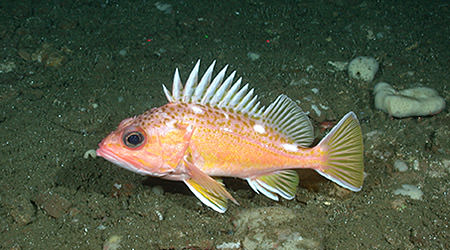Fishing Impacts
Cordell Bank

Why is it a concern?
Fish populations within CBNMS are affected by predator-prey relationships, variable recruitment, changing environmental conditions and harvest. Ecosystem management is increasingly recognizing food web complexities and the ecological importance of fishes providing a critical energetic link supporting populations at higher trophic levels. The drought conditions in California are creating extreme challenges for salmonids that leave ocean habitats including CBNMS to migrate up rivers and streams to spawn. Many of these streams also lack the water flow necessary to provide adequate habitat for young salmon migrating downstream to the ocean where they will begin the adult phase of their lives.
Areas within Cordell Bank National Marine Sanctuary (CBNMS or Sanctuary) have been closed to commercial and recreational fishing as part of the Pacific Fishery Management Council's rebuilding plan for over-harvested groundfish stocks. These areas occur on Cordell Bank and on shelf and slope areas adjacent to the Bank. Some of these areas have been closed for over ten years, but the effect of recent closures and the degree that Cordell Bank contributes to regional groundfish populations are poorly known.
The ecological impact of over harvesting has cascading effects in the marine ecosystem. Fishes provide key links among multiple trophic levels in ocean food webs as both predator and prey, and significant ecosystem disturbances occur when fish populations are over harvested. Large portions of the Sanctuary have been closed to fishing since 2003 to facilitate the rebuilding of depleted groundfish stocks. It is unknown how well populations have recovered at Cordell Bank.
In addition, the genetic structure and source of the fish populations in CBNMS are unknown. It is possible that the unique bathymetry of the Bank coupled with its proximity to the shelf break and Bodega Canyon creates local oceanographic features that concentrate larval settlement at the Bank. It is unknown whether larvae released at Cordell Bank are retained within this local area or are widely dispersed, thus populating areas outside of the Sanctuary. To adequately protect and manage the Sanctuary, the effect of area closures and the contribution of Cordell Bank to the recovery of depleted fish populations need to be determined.
Overview of Research
Research conducted by Sanctuary scientists and partners provides critical information to address existing and emerging resource conservation and management issues. The Overview of Research highlights some, but not necessarily all, of the research activities completed or ongoing at the Sanctuary.
The sanctuary and partners conducted an assessment of fishes and habitat on Cordell Bank from 2002 to 2005 at the onset of fishery closures implemented by the Pacific Fisheries Management Council. These surveys along with results from more recent work will help us track the status of some groundfish populations on the Bank. The National Marine Fisheries Service conducts annual midwater trawl surveys to measure recruitment success of many species of juvenile fishes in the California Current. These data provide important information to understand the level of juvenile groundfish settling on Cordell Bank each year.
Sanctuary staff and partners have conducted surveys using a camera sled and remotely operated vehicle to characterize fishes using the soft bottom habitats on the continental shelf and slope. Results from these surveys can be assessed along with results from long term bottom trawl surveys conducted by the National Marine Fisheries Service to begin assessing soft bottom fish communities in the sanctuary.
| Project Name | PI and contacts | Links |
|---|---|---|
Cordell Bank Habitat Chracterizatin and Biological Monitoring |
Dale Roberts, Lisa Etherington, Tara Anderson |
http://sanctuarysimon.org/projects/ |
Remotely-operated vehicle surveys of CBNMS |
Science Needs and Questions
The best available science is used by Sanctuary scientists and managers working to address priority resource conservation and management issues. As priorities change and new issues emerge, each Sanctuary develops new science needs and questions and works with partners to address them.
- See the CBNMS Science Need Assessment related to marine zones for additional information
- Have area closures affected the species composition, distribution, size, and abundance of fishes and invertebrates on Cordell Bank?
- To what extent have fish populations recovered at Cordell Bank?
- What is the genetic structure of fish populations in CBNMS and surrounding areas?
- What are the sources of fish and invertebrate recruits to Cordell Bank?
- What is the contribution of Cordell Bank fishes and invertebrates to populations outside the sanctuary?
Education and Outreach Material
Please refer to the Cordell Bank National Marine Sanctuary website to learn more about education and outreach materials.
References
Anderson, T.J., C. Syms, D.A. Roberts, D.F. Howard. 2009. Multi-scale fish-habitat associations and the use of habitat surrogates to predict the organisation and abundance of deep-water fish assemblages. Journal of Experimental Marine Biology and Ecology 379(1-2): 34-42.
Office of National Marine Sanctuaries. 2008. Cordell Bank National Marine Sanctuary Condition Report 2008. U.S. Department of Commerce, National Oceanic and Atmospheric Administration, Office of National Marine Sanctuaries, Silver Spring, MD. 42pp.
Office of National Marine Sanctuaries. 2010. Cordell Bank Science Needs, Fish Spawning. U.S. Department of Commerce, National Oceanic and Atmospheric Administration, Office of National Marine Sanctuaries, Silver Spring, MD, Accessed: 7/22/2014
Ralston, S. 2003. West coast groundfish: the rockfish problem. In: G. M. Watters (ed.), Proceedings of the NMFS Workshop on Building Environmentally Explicit Stock Assessments, Pacific Fisheries Environmental Laboratory, SWFSC, Pacific Grove, CA.
Young, M.A., P. J. Iampietro, R.G. Kvitek, and C.D. Garza. 2010. Multivariate bathymetry-derived generalized linear model accurately predicts rockfish distribution on Cordell Bank, California, USA. Marine Ecology Progress Series 415:247-261.

